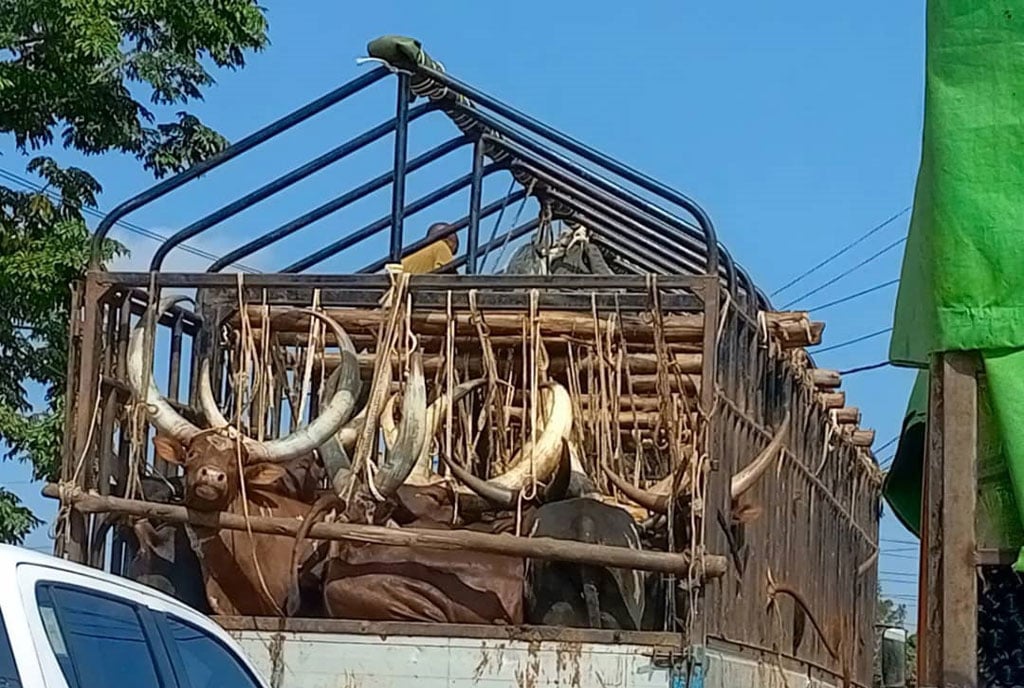Concerns over cruelty on animals on transit

Livestock in transit on the Gulu-Kampala highway. PHOTO/DAN WANDERA
What you need to know:
- They say the whipping, tail twisting, head twisting and use of sharp objects to pierce the animals on top of overloading partly compromise the quality of the meat.
A section of the public has expressed concern about the cruel manner in which animals and poultry are transported to livestock markets and abattoirs.
They say the whipping, tail twisting, head twisting and use of sharp objects to pierce the animals on top of overloading partly compromise the quality of the meat.
On October 22, a truck transporting about 20 head of cattle from Nakaseke District to Kampala City suddenly stopped at Naluvule Village, about 6kms from Luweero Town on the Kampala-Gulu highway.
This was after one of the animal handlers (transporter) realised that one of the cows was gasping for air after being strangled by ropes tied around its neck. They had to offload the animal and slaughter it by the roadside.
A boda boda rider, who helped get the sharp knives to help skin the animal, reveals that the transporters engaged in a blame game over its condition.
“These animals have not had any water for two days. We have transported them for more than 280kms from Masindi via Nakaseke District without water and food. We might lose more animals,” one of the transporters was quoted by the boda boda cyclist as saying.
Mr Abdul Ssengendo, a resident of Kalerwe in Kampala City, says the animals have to be subdued if they are to be transported easily.
"You have to twist and tie their tails against the poles. This is a bit [wrong] because you almost cut off the blood flow and in most cases, the tail develops a darkish colour because of the reduced blood flow, rendering the animal calm,” Mr Ssengendo further explains.
Mr Yudah Ssendagire, a butcher in Wobulenzi Town Council, Luweero District, says the animal transporters, locally known as Bayana, are used to the brutal acts meted out to the animals in transit.
“For animals that prove very stubborn, a sharp stick is pushed through the eye and the nose. These men are heartless and use brutal means to subdue the animals. I failed to cope with this type of work after witnessing the brutality meted at the animals,” he reveals.
In 2022, the Ministry of Agriculture Animal Industry and Fisheries drafted guidelines and standard operating procedures for handling and transportation of live animals in Uganda.
The Animals’ Prevention of Cruelty Act Cap 39 prohibits whipping of animals, tail twisting or tying, head twisting or tying, and applying pressure on the eyes of animals, ears and external genitalia that cause pain and suffering to the animals.
Traffic police officers manning the Kampala-Gulu and the Kampala-Hoima highways say they are aware of the cruel acts against animals in transit.
“We arrest overloaded cattle trucks but we are yet to get a circular detailing the animal handling process to clearly enforce guidelines on animal transportation. Many of the cows have their tails twisted and the heads are hanging by the horns while in transit,” a police traffic officer at a roadblock on the Kampala –Gulu highway, told Daily Monitor.
Dr John Mary Gibugonyi, a retired veterinary officer, says more than 50 percent of the meat sold in the urban abattoirs is below standard and likely unsafe partly because of the poor animal handling methods.
“By the time the animals get slaughtered, they are stressed and the meat is compromised. Animals that have been whipped, tails and heads twisted and pierced with sharp objects cannot produce safe animal products, including the meat,” he says.
The Ministry of Agriculture Permanent Secretary, Maj Gen David Kasura Kyomukama, says the poor transportation of animals affects the quality of both the livestock products and the health of the animals.
“As a ministry, we have the guidelines in place but the problem could be with the enforcement process. The ministry does not have its own police to enforce the guidelines. We also have the district veterinary teams supposed to ensure that the transporters follow the set guidelines,” he says.
The government, he says, plans to set up abattoirs and meat factories upcountry to reduce transportation of live animals. “Some of the value chain livestock infrastructure is being set up through government-private partnerships. We have a modern abattoir in Migeera (Nakasongola). The revival of the Soroti Meat packers is in the pipeline among other infrastructure,” he adds.
BACKGROUND
Statistics from the Animal Health Department at the Ministry of Agriculture for the year 2019 indicate that an estimated 436,073 live animals and 65,231 poultry were transported between and within 58 districts. The data also indicate that 87.49 percent of the transported animals were for slaughter while 12.5 percent were for sale.





